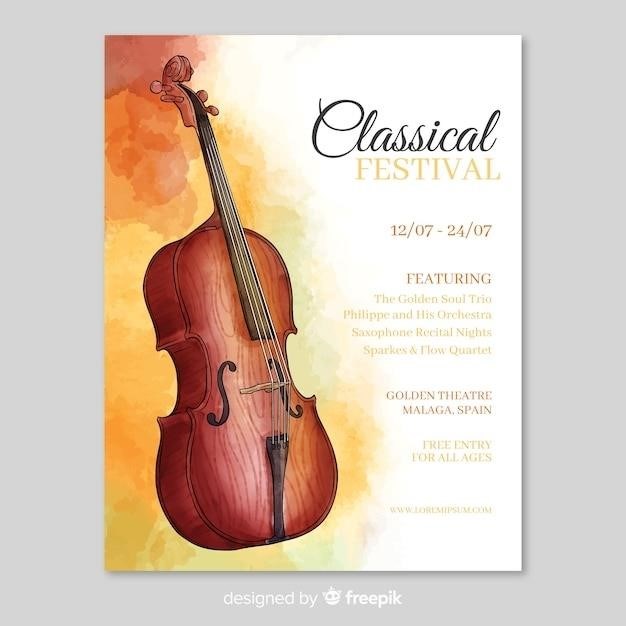Henry Schradieck⁚ A Biographical Overview
Henry Schradieck (1846-1918), a German violinist and pedagogue, was a leading violin teacher. His renowned etude books remain widely used. Born in Hamburg, he received early instruction from his father and debuted publicly at six. Further studies followed in Brussels under Leonard.
Early Life and Education
Henry Schradieck’s early life and musical training laid the foundation for his significant contributions to violin pedagogy. Born in Hamburg, Germany, on April 29, 1846, he received his initial violin instruction from his father, a testament to the familial influence on his musical journey. This early exposure undoubtedly fostered a deep-seated passion for the instrument and a profound understanding of its technical intricacies. The details of his early education beyond his father’s tutelage are not readily available in the provided text, leaving room for further research into the formative years that shaped his musical capabilities. However, what is clear is that his foundational musical training significantly impacted his future role as a renowned violin teacher and composer;
His subsequent studies in Brussels under the guidance of Leonard, a prominent figure in the violin world, further solidified his technical expertise and broadened his artistic horizons. This period of formal instruction provided Schradieck with a structured approach to learning and playing the violin, an element he likely incorporated into his own teaching methods. The influence of his education is undoubtedly reflected in his pedagogical works, which are still valued and studied by violinists worldwide, demonstrating the enduring legacy of his early life and training.
Teaching Career and Notable Students
Henry Schradieck’s career as a violin pedagogue was marked by his profound influence on generations of violinists. While specifics about the locations and institutions where he taught are limited in the provided text, his reputation as one of the foremost violin teachers of his time is well-established. His pedagogical approach, clearly articulated in his widely-used “School of Violin Technics,” emphasized a systematic and thorough development of technical skills. This method, focusing on dexterity, double stops, and varied bowing techniques, provided a comprehensive framework for aspiring violinists. The enduring popularity of his etude books speaks volumes about the effectiveness and lasting impact of his teaching methods.
Among his notable students, the names of Ottokar Nováček, Norman Black, and Theodore Spiering stand out, highlighting the breadth and depth of his influence on the musical landscape. These individuals, having benefited from Schradieck’s instruction, went on to achieve their own success and recognition in the world of music. The success of his students serves as a powerful testament to his teaching prowess and the enduring value of his pedagogical approach. Further research is needed to uncover more details about his teaching career and the complete list of his students, but the available information points to a highly influential and impactful career.
Legacy and Influence on Violin Pedagogy
Henry Schradieck’s impact on violin pedagogy extends far beyond his lifetime. His “School of Violin Technics,” a three-book series of etude collections, remains a cornerstone of violin education. These meticulously crafted exercises, focusing on dexterity, double stops, and bowing techniques, continue to be used by teachers and students worldwide. The systematic approach within his method provides a comprehensive path for developing technical proficiency on the violin. This enduring relevance underscores the timelessness and effectiveness of his pedagogical principles. The exercises are not merely technical drills; they cultivate musicality and expression through controlled development of physical skills;
Schradieck’s legacy lies not only in the continued use of his etudes but also in the generations of violinists who have benefited from his approach. The influence of his teaching extends to his notable students, who themselves became prominent figures in the world of music. His contribution to the development of violin technique and pedagogy continues to shape the musical education of violinists today. The enduring popularity and ongoing use of his “School of Violin Technics” solidify his place as a foundational figure in violin pedagogy, leaving an indelible mark on the instrument’s pedagogical history.

Schradieck’s “School of Violin Technics”⁚ A Detailed Examination
This renowned three-book series systematically develops violin technique. Each book focuses on a specific aspect⁚ dexterity, double stops, and varied bowing. These exercises remain highly valued for their effectiveness and comprehensive approach to technical mastery.
Book 1⁚ Exercises for Promoting Dexterity
Schradieck’s “School of Violin Technics,” Book 1, is dedicated to cultivating dexterity across various positions on the fingerboard. The exercises are meticulously structured, progressing from simple to complex patterns. Early studies focus on single-string exercises, building fundamental finger strength and accuracy; As the book advances, exercises incorporate shifts and position changes, demanding smooth transitions and precise intonation. This systematic approach ensures that students develop a strong foundation in left-hand technique. The exercises are designed to be practiced slowly and methodically, emphasizing accuracy over speed. Regular practice of these exercises enhances finger independence and agility, crucial for playing technically demanding passages. The carefully chosen scales and arpeggios are tailored to improve the student’s overall dexterity and control over the instrument, laying a solid foundation for more advanced studies. The book’s practical and progressive structure makes it an excellent resource for violinists of all levels, from beginners seeking to improve their fundamental skills to advanced players looking to refine their technique. Book 1’s exercises are readily available in PDF format online, providing convenient access to this timeless pedagogical resource. Many websites offer free downloads, although caution is advisable to ensure the legality and quality of the source.
Book 2⁚ Exercises in Double Stops
Schradieck’s “School of Violin Technics,” Book 2, delves into the intricacies of double stops, a crucial aspect of violin playing. This section systematically introduces various double-stop combinations, progressing from simple intervals to more complex chords. The exercises are designed to develop even bowing, precise intonation, and independent finger control in both hands. Maintaining equal tone and volume between the two strings is emphasized, requiring careful attention to bowing technique and finger pressure. The book progresses through various keys and positions, ensuring that the student gains proficiency across the fingerboard. Schradieck’s approach is methodical, starting with simple parallel intervals before moving to more challenging combinations and wider intervals. Each exercise is carefully constructed to address specific technical challenges, such as intonation issues and bow distribution. The exercises are particularly useful for developing a strong sense of pitch and coordination between the left and right hands. Many online resources offer Book 2 in PDF format, allowing students convenient access to these valuable exercises. However, it’s crucial to ensure that the downloaded PDF is from a reputable source to guarantee both its accuracy and legality, ensuring a valuable learning experience.
Book 3⁚ Exercises in Various Bowing
Schradieck’s “School of Violin Technics,” Book 3, focuses on the mastery of diverse bowing techniques. This volume expands on fundamental bowing skills, introducing a range of strokes and articulations crucial for expressive playing. The exercises systematically explore détaché, legato, martelé, staccato, and other bowing styles, building a solid foundation in each. Students learn to control bow speed, pressure, and weight to achieve varied tonal qualities and articulations. The exercises incorporate different rhythmic patterns and note values, enhancing rhythmic precision and coordination with bowing. Schradieck’s progressive approach starts with simpler exercises before gradually increasing complexity. This ensures students develop control and accuracy in each bowing style before tackling more demanding passages. The book’s value lies in its structured approach, guiding violinists from basic techniques to advanced control. Book 3 is readily available in PDF format online, but users must be cautious, ensuring they obtain copies from reliable sources to maintain accuracy and respect copyright. This ensures the student can fully benefit from Schradieck’s comprehensive approach to bowing technique.

Accessing Schradieck’s Works in PDF Format
Numerous online sources offer Schradieck’s violin studies as PDFs. However, legality and reliability vary widely; carefully choose reputable sites to ensure you are accessing legitimate, accurate copies of his works.
Availability and Legality of Online Resources
Finding Schradieck’s “School of Violin Technics” in PDF format online is relatively straightforward. Many websites offer downloads, often claiming public domain status. However, the legal landscape surrounding these online resources is complex and often murky. Copyright laws vary across jurisdictions and the passage of time doesn’t automatically render a work public domain. Simply because a PDF is available doesn’t guarantee its legal accessibility. Some sites may host pirated copies, infringing on copyright, while others may offer legitimate, freely available editions. Determining the legal status requires careful examination of the source’s claims and understanding the specifics of copyright law concerning the specific edition. It’s crucial to avoid contributing to copyright infringement by only using resources that clearly state their legal status and licensing terms, respecting the intellectual property rights of the composer and publisher.
Finding Reputable Sources for Downloading
Securing legitimate Schradieck PDFs demands diligence. While numerous websites host these materials, verifying their authenticity and legal standing is paramount. Reputable sources often include established online sheet music libraries, digital archives affiliated with universities or major music institutions, or publishers specializing in historical violin pedagogic materials. These sources generally provide clear copyright information, licensing details, and often high-quality scans or transcriptions. Be wary of sites with unclear origins or those lacking information about copyright. Look for established websites with user reviews, community forums, or professional endorsements to increase the likelihood of finding legitimate copies. Checking the file metadata for information about the source and scanner can also help verify the authenticity of the PDF. Remember, downloading from unreliable sources risks acquiring low-quality scans, inaccurate transcriptions, or even malware.